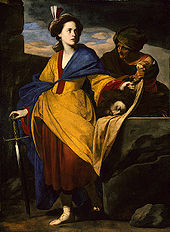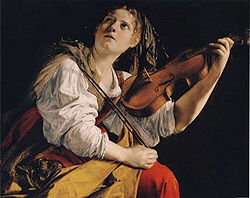- Massimo Stanzione
-
 Judith with the Head of Holophernes, ca 1630-35 (Metropolitan Museum of Art)
Judith with the Head of Holophernes, ca 1630-35 (Metropolitan Museum of Art)
Massimo Stanzione (also called Stanzioni; c. 1586 - c. 1656) was an Italian Baroque painter, mainly active in Naples.
Massimo Stanzione was an Italian Baroque painter. Born in Naples in 1586, Massimo was greatly influenced by Michelangelo Merisi da Caravaggio, but what earned him the nickname of The Neapolitan Guido Reni was his sophisticated and graceful style. The thing that distinguished Massimo’s art from Carravaggism was that he combined Caravaggio’s dramatically lit and brutally realistic style with the classical and lyrical manner of Bolognesi painters.
Contents
Early years
Though his preliminary training is uncertain, it is thought that he studied with Fabrizio Santafede; however, most of the influence he received was from Caravaggio. Art historians believe that Stanzione developed his career as an artist in Rome. It is thought that he bagan his career as a portraitist. Some of his most famous works include Portrait of a Woman in Popular Costume, and Portrait of Jerome Banks. Between 1617 and 1630, it is believed that he traveled between the papal city and his hometown of Naples exploring different styles of art. Also influenced by Caravaggio were Artemisia Gentileschi, Simon Vouet, and Carlo Saraceni. During Stanzione’s career a movement that changed the style of art was formed. Stanzione was a part of this movement. This movement transformed the dark, contrasted Caravaggio-styled art into Bolognese colorism and soft art.
Career beginnings
Massimo was the principal Neapolitan painter in the beginning of the 17th century. This was due to his vast altarpieces and frescoes and of course his following of students and imitators. He and his rival Jusepe de Ribera dominated the painting scene in Naples. Massimo’s rich color and idealized naturalism not only got him the name ‘il Guido Reni napoletano’, but it had a large influence on other local artists, such as Francesco Solimena. It is believed that Massimo Stanzione died during the plague of 1656.
Naples was the second largest city after Paris during the 17th century. In 1630, it was a center of opportunity for artistic commissions. Many of these artistic commissions were sought after by the Spanish Viceroys who maintained positions of political power in Naples at this time. Other art enthusiasts arrived from various Mediterranean ports in Naples looking for artistic expertise. Stanzione along with Bernardo Cavallino and most importantly Artemisia Gentlileschi represented a new and more graceful painting style. This style replaced Caravaggesque’s naturalism.
Apparently Stanzione’s artistic relationship with Gentileschi was significant in his development as an artist. Documentation shows that Stanzione and Gentileschi both moved to Naples the same year, 1630. De Dominici describes the relationship between Gentileschi and Stanzione as an informal apprenticeship. Stanzione joined Artemisia daily to observe her while she painted and may have imitated her coloring style, but not her design style. There is no written proof to substantiate this hypothesis because the fact remains that Stanzione had a tremendous amount of interaction with other colorists throughout this time and also he was already established artistically in Rome by 1617 when he was working with Saraceni and Honthrost at the Santa Maria della Scala. The S.M. della Scala was one of the first hospitals in Europe. The hospital had its own organization, which was set up as a means to care for pilgrims, assist the poor and provide for abandoned children.
However, later writers credited Artemisia with influencing Stanzione’s rich light effects and greater classicizing. Gentileschi and Stanzioni collaborated on certain works such as Birth of St. John the Baptist. This painting was for Philip IV’s Buen Retiro Palace. The two artists compromised their styles; Gentileschi subdued her realist style of tenebrism and substituted it with more even lighting and classical composition, and the two succeeded in creating an agreeable collection. Stanzione’s Saint Agatha In Prison along with his Young Saint John the Baptist were his first known works. Those works combine the influence of Reni and Domenichino among others to create a composition of “lyric classicism”.
Baroque art
Born in Rome, Baroque art is a style, which includes painting, sculpture, and architecture. Baroque was a very leading style in Europe from 1590 to1730, taking on multiple forms in various countries. Having been a direct product of mannerism, Baroque is characterized by light/shade (chiaroscuro), rich ornamentation, emotionalism, illusion, and the increased use of color. Two artists that are noted for their development in Baroque art are Bernini and Rubens.
David With the Head of Goliath
In 1947, Mrs. Harry Turpin gifted a Stanzione original painting titled David With the Head of Goliath to the Fine Arts Gallery of San Diego (now the San Diego Museum of Art); the work was then attributed to Ribera, but was reattributed to Stanzione by Mario Modestini in 1951, an attribution confirmed by Schleier, Felton, Zeri, and Spinosa. The painting is dated to approximately 1630. Caravaggio was an important influence in Stanzione’s artistic style and this painting illustrates a combination of styles from Caravaggio’s brutally realistic elements and dramatic lighting to classical 17th century artistic trends including the lyrical style of Bologna artists. This painting shows David in an elegant posture, which softens the goriness, i.e. the dismembered head of Goliath. The theatrical lighting of this painting is a perfect demonstration of the chiaroscuro interpretation by Stanzione. Guido and Caravaggio can be credited for Stanzione’s interpretation of chiaroscuro; they were supposedly his teachers. Interestingly enough, it was only after the painting was donated, that experts noticed under gallery lighting some aberrations in the canvas such as unevenness and crackle patterns. Those aberrations, along with the fact that young David appears to be gazing at something in the lower left corner led to suspicions that the canvas had been altered. By 1999, with the use of x-rays and careful removal of surface paint, the original paint of Goliath’s forehead was revealed. After intensive restoration, Goliath’s full face was uncovered and the painting restored to its original form. The full painting depicts Goliath’s dismembered head in the lower left corner, with David, knife in hand, gazing down to the lower left corner. It is believed that the head of Goliath was painted over in order to make the painting less gory and more appealing to potential buyers.
References
- Lahti, N.E. (1993). The Language of Art from A to Z: Writin Plain English. Terrebonne, Or. 1997.
- Lucie-Smith, Edward (2004). The Thames & Hudson Dictionary of Art Terms. New York, N.Y. Thames & Hudso, 2004.
- Garrard, Mary D. (2006). Artemisia Gentileschi. New York, N.Y.. Rizzoli International Publications, 1993.
- Langmuir, Erika D. (2000). The Yale Dictionary of Art and Artists. New Haven, CT. Yale UP, 2000.
- Ribera, José De (2006). Ribera. Naples. 2006.
- Christiansen, Keith (2001). Orazio and Artemisia Gentileschi. New York, NY. 2001.
External links
Categories:- Caravaggisti
- 1580s births
- 1660s deaths
- People from the Province of Caserta
- Italian painters
- Neapolitan painters
- Italian Baroque painters
Wikimedia Foundation. 2010.

